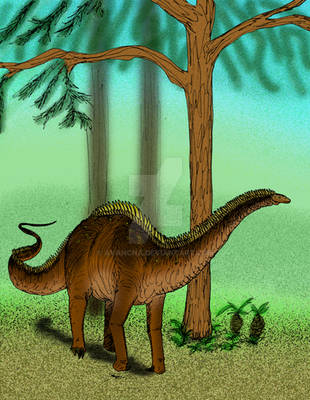ShopDreamUp AI ArtDreamUp
Deviation Actions
Suggested Deviants
Suggested Collections
You Might Like…
Description
Sauropodomorpha>Neosauropoda>Diplodocoidea>Diplodocidae>Apatosaurinae>Brontosaurus>B.louisae
Holland, 1916
Time: Late Kimmeridgian- Early Tithonian (~152-150 million years ago)
Length: Up to 23.2 meters (76.1ft) when fully grown, based on specimen CM 3018.
Height: Up to 4.5 meters (14.7ft) at the highest point of the back when fully grown.
Weight: Up to 22 tonnes, possibly more depending on scaling issues.
Habitat: The Dinosaur National Monument of Utah, U.S, North America.
Ecology: Large terrestrial megaherbivore. Like other diplodocids, it probably fed on lower heights when compared to similarly-sized sauropods, probably around 1-5 meters off the ground. They may have used the claws on their front feet to gain more balance against tree trunks when feeding in a reared-up pose.
Diet: Foliage from ferns, tree ferns, cycads etc. Studies have been made to estimate its daily water intake, which would be expected at roughly 262 liters, or 69 US gallons of water a day for a fully grown adult.
Locomotion: While adults were obligate quadrupeds like all sauropods, some tracks may indicate that juveniles could be facultative bipeds, walking on their hind legs from time to time. Their top speed has been estimated at 20-30 kph (12-19 miles an hour) by unknown methods, but 3d runcycles for Diplodocus indicate that it more likely moved between 10-18km/h (6.2-11.2 mph), although higher maximum speeds are possible. Other diplodocids such as Brontosaurus probably held similar speeds.
Potential predators: Hatchlings were probably preyed upon by theropods like Tanycolagreus, Ornitholestes and Stokesosaurus, or pterosaurs such as Harpactognathus, and juveniles by theropods such as Allosaurus, Ceratosaurus and Torvosaurus. Adults may have been in the menu of the largest individuals of Allosaurus in rare occasions, but were otherwise immune to predation.
-------------------------------------------------------------------------------------------------------------------------------------------------------------------------
Update 07/15/17:
-Lineart completely remade.
-Replaced human scale figure.
-More accurate size estimate, now along the centra as is the norm, instead of in a straight line.
-Updated scientific name (Bronto FTW)
-Minor text corrections.
Skeletal reconstruction by
Holland, 1916
Time: Late Kimmeridgian- Early Tithonian (~152-150 million years ago)
Length: Up to 23.2 meters (76.1ft) when fully grown, based on specimen CM 3018.
Height: Up to 4.5 meters (14.7ft) at the highest point of the back when fully grown.
Weight: Up to 22 tonnes, possibly more depending on scaling issues.
Habitat: The Dinosaur National Monument of Utah, U.S, North America.
Ecology: Large terrestrial megaherbivore. Like other diplodocids, it probably fed on lower heights when compared to similarly-sized sauropods, probably around 1-5 meters off the ground. They may have used the claws on their front feet to gain more balance against tree trunks when feeding in a reared-up pose.
Diet: Foliage from ferns, tree ferns, cycads etc. Studies have been made to estimate its daily water intake, which would be expected at roughly 262 liters, or 69 US gallons of water a day for a fully grown adult.
Locomotion: While adults were obligate quadrupeds like all sauropods, some tracks may indicate that juveniles could be facultative bipeds, walking on their hind legs from time to time. Their top speed has been estimated at 20-30 kph (12-19 miles an hour) by unknown methods, but 3d runcycles for Diplodocus indicate that it more likely moved between 10-18km/h (6.2-11.2 mph), although higher maximum speeds are possible. Other diplodocids such as Brontosaurus probably held similar speeds.
Potential predators: Hatchlings were probably preyed upon by theropods like Tanycolagreus, Ornitholestes and Stokesosaurus, or pterosaurs such as Harpactognathus, and juveniles by theropods such as Allosaurus, Ceratosaurus and Torvosaurus. Adults may have been in the menu of the largest individuals of Allosaurus in rare occasions, but were otherwise immune to predation.
-------------------------------------------------------------------------------------------------------------------------------------------------------------------------
Update 07/15/17:
-Lineart completely remade.
-Replaced human scale figure.
-More accurate size estimate, now along the centra as is the norm, instead of in a straight line.
-Updated scientific name (Bronto FTW)
-Minor text corrections.
Skeletal reconstruction by
Image size
2332x829px 182.01 KB
© 2016 - 2024 randomdinos
Comments58
Join the community to add your comment. Already a deviant? Log In
I am not sure if Sauropods really had spikes on the bottom of their necks, but it would give them, especially the vulnerable Sauropodlets, protection from predators.

































